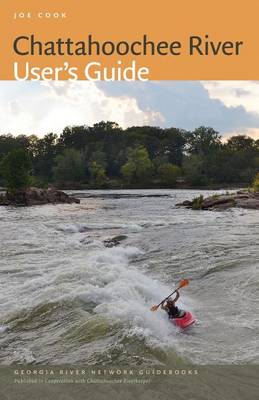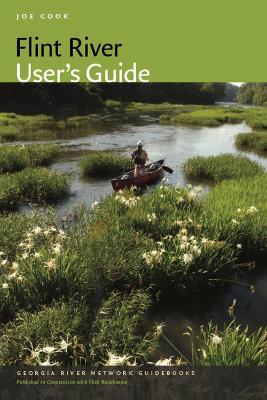Georgia River Network Guidebooks
4 total works
The Chattahoochee River is one of the premier waterways of Georgia and the Southeast. It is a mecca for summer recreation, a priceless natural resource that provides water and power for a great number of Georgia's citizens, and an essential component to the region's ecosystem. As public interest in both exploring and protecting Georgia's rivers such as the Chattahoochee grows, so too has the demand for clear and elegant guides to our rivers. The Chattahoochee River User's Guide - the latest in a series of river guides from Georgia River Network and the University of Georgia Press - aims to meet that demand.
The Chattahoochee River User's Guide traces the 430-mile course of the Hooch from its headwaters at a spring on Coon Den Ridge near Jacks Knob in northeastern Georgia to its confluence with the Flint River, where they form the Apalachicola River. The Georgia River network guides provide many little-known facts about Georgia's rivers, bring to life these rivers' cultural and natural history, and present river issues in an immersive and engaging manner that will inspire users to help protect their local waterways.Features:200 colour photographs 32 user-friendly maps that reveal the towns, roads, entry points, bridges, public lands, parks, and other landmarks along the river's course from the southern Blue Ridge Mountains to the Georgia-Florida borderDetailed practical information about public access points, potential hazards, camping facilities, and GPS coordinates for points of interest A primer on fishingAn introduction and safety overview, as well as a concise natural history guide to common flora and fauna of the river corridor
The Chattahoochee River User's Guide traces the 430-mile course of the Hooch from its headwaters at a spring on Coon Den Ridge near Jacks Knob in northeastern Georgia to its confluence with the Flint River, where they form the Apalachicola River. The Georgia River network guides provide many little-known facts about Georgia's rivers, bring to life these rivers' cultural and natural history, and present river issues in an immersive and engaging manner that will inspire users to help protect their local waterways.Features:200 colour photographs 32 user-friendly maps that reveal the towns, roads, entry points, bridges, public lands, parks, and other landmarks along the river's course from the southern Blue Ridge Mountains to the Georgia-Florida borderDetailed practical information about public access points, potential hazards, camping facilities, and GPS coordinates for points of interest A primer on fishingAn introduction and safety overview, as well as a concise natural history guide to common flora and fauna of the river corridor
The Broad River is among the last free-flowing rivers in Georgia and perhaps the state's most wild. The Broad River User's Guide traces the unique characteristics of the full 60 miles of the river and the 110 miles of its three forks (South, Middle, and North) before the main river's convergence with the Savannah River.
In doing so, the guide outlines the river's cultural and natural history, telling the story of humans' relationship to the river from precolonial days to the present. Though the mainstem of the Broad is one of the few Georgia rivers to escape dams, it was one of Georgia's first inland river valleys to be explored and settled. Along its course are rare species like shoals spider lilies and the Bartram's bass, not to mention some of the most popular whitewater paddling in North Georgia.
With this handbook, river explorers will find all the information needed to embark on a Broad River journey, including detailed maps, put in/take out suggestions, fishing and camping locations, mile-by-mile points of interest, and an illustrated natural history guide to help identify animals and plants commonly seen in and around the river.
This guide includes:
an introduction and overview of the riverchapters describing each river section with detailed maps and notes on river access and points of interest
a compact natural history guide featuring species of interest found along Georgia's rivers
notes on safety and boating etiquette
a fishing primer
notes on organizations working to protect the river
In doing so, the guide outlines the river's cultural and natural history, telling the story of humans' relationship to the river from precolonial days to the present. Though the mainstem of the Broad is one of the few Georgia rivers to escape dams, it was one of Georgia's first inland river valleys to be explored and settled. Along its course are rare species like shoals spider lilies and the Bartram's bass, not to mention some of the most popular whitewater paddling in North Georgia.
With this handbook, river explorers will find all the information needed to embark on a Broad River journey, including detailed maps, put in/take out suggestions, fishing and camping locations, mile-by-mile points of interest, and an illustrated natural history guide to help identify animals and plants commonly seen in and around the river.
This guide includes:
an introduction and overview of the riverchapters describing each river section with detailed maps and notes on river access and points of interest
a compact natural history guide featuring species of interest found along Georgia's rivers
notes on safety and boating etiquette
a fishing primer
notes on organizations working to protect the river
The Flint River is arguably Georgia's most beautiful river, and in terms of the terrain through which it flows on its 344-mile journey, there is not another Georgia river that exposes the river traveler to more diverse vistas. From the bottomland swamps in its headwaters, through soaring views of Pine Mountain and rapids in the Piedmont, to breathtakingly clear springs in the Coastal Plain, the Flint is filled with surprises at virtually every bend.
The Flint River User's Guide, the fourth in a series of Georgia River Network recreational guidebooks, is a portal to adventure on this spectacular river. The book brings to life the river's cultural and natural heritage while providing all the details needed to get out on the river and enjoy it via canoe, kayak, paddleboard, or motorized vessel.
Whether in your canoe, on the river, or on your couch at home, the Flint River User's Guide will immerse you in the story of the river, which also happens to be the story of those communities along its course from the headwaters in the suburbs of metro Atlanta to the backwaters of Lake Seminole near the Florida state line.
The Flint River User's Guide, the fourth in a series of Georgia River Network recreational guidebooks, is a portal to adventure on this spectacular river. The book brings to life the river's cultural and natural heritage while providing all the details needed to get out on the river and enjoy it via canoe, kayak, paddleboard, or motorized vessel.
Whether in your canoe, on the river, or on your couch at home, the Flint River User's Guide will immerse you in the story of the river, which also happens to be the story of those communities along its course from the headwaters in the suburbs of metro Atlanta to the backwaters of Lake Seminole near the Florida state line.
From its small headwaters in Hall County, Georgia, the North Oconee winds nearly seventy miles, tumbling over granite outcroppings at Hurricane Shoals and on to Athens, where it meets the Middle Oconee. From there, the Oconee courses 220 miles through east-central Georgia to meet the Ocmulgee convergence near Lumber City, forming the Altamaha River, which flows to the Atlantic Ocean. As the Oconee's importance as a recreational amenity has grown over the years, University of Georgia students and instructors, the Altamaha Riverkeeper, Georgia River Network, Upper Oconee Watershed Network, and the North Oconee River Greenway have worked together to create a plan for water trails and recreational trails along the river as it flows through Athens.
In the Oconee River User's Guide, both novice and experienced water sports enthusiasts will find all the information required to enjoy the river, including detailed maps, put in and take out suggestions, fishing and camping locations, mile-by-mile points of interest, and an illustrated guide to the animals and plants commonly seen in and around the river. Daytrippers will enjoy Joe Cook's fascinating description of the cultural and natural heritage of this richly diverse waterway.
The Oconee River is home to seventy-four species of fish, including the Altamaha shiner, found only in the Altamaha River basin, as well as thirty-seven species of salamanders and frogs and forty-three species of reptiles, including the American alligator, found in the lower Oconee downstream of Milledgeville.
FEATURES:
In the Oconee River User's Guide, both novice and experienced water sports enthusiasts will find all the information required to enjoy the river, including detailed maps, put in and take out suggestions, fishing and camping locations, mile-by-mile points of interest, and an illustrated guide to the animals and plants commonly seen in and around the river. Daytrippers will enjoy Joe Cook's fascinating description of the cultural and natural heritage of this richly diverse waterway.
The Oconee River is home to seventy-four species of fish, including the Altamaha shiner, found only in the Altamaha River basin, as well as thirty-seven species of salamanders and frogs and forty-three species of reptiles, including the American alligator, found in the lower Oconee downstream of Milledgeville.
FEATURES:
- an introduction and overview of the river
- chapters describing each river section with detailed maps and notes on river access and points of interest
- a compact natural history guide featuring species of interest found along Georgia's rivers
- notes on safety and boating etiquette
- a fishing primer
- notes on organizations working to protect the river



